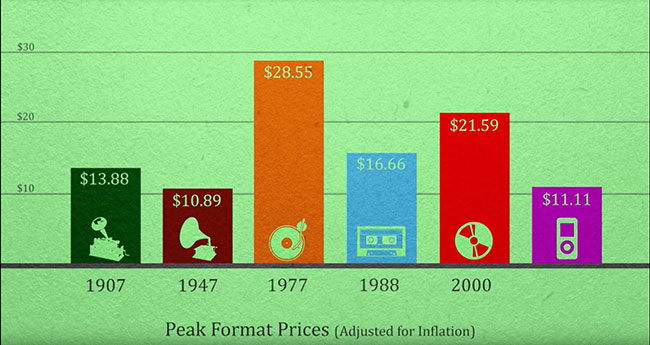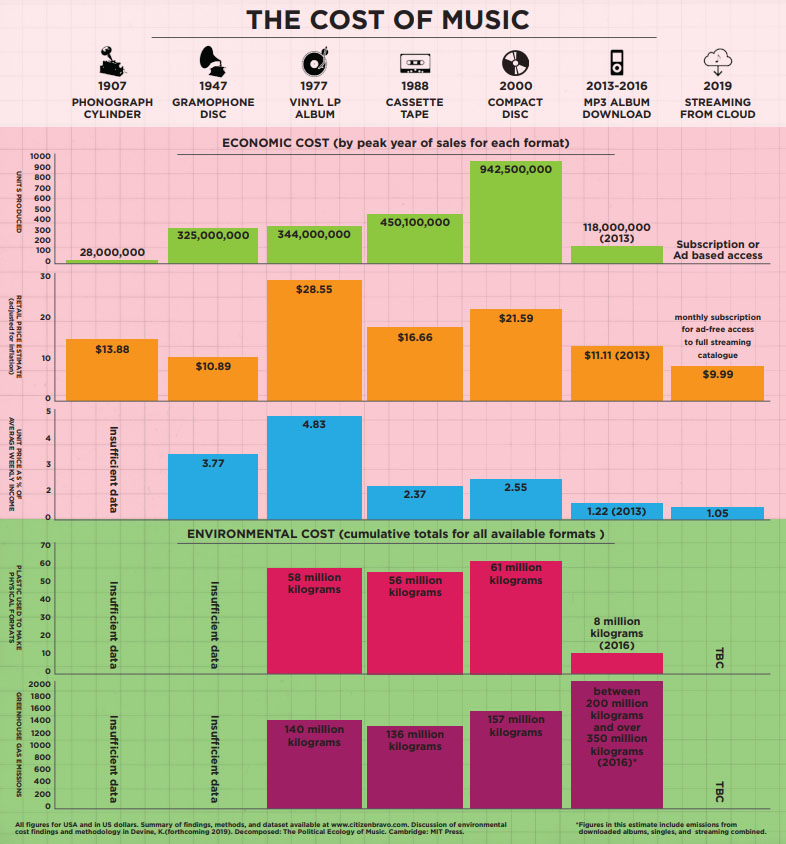The Cost of Music
Researchers at the University of Glasgow and University of Oslo have examined the economic and environmental cost of recorded music in order to raise awareness about its sustainability.
Dr Matt Brennan from the University of Glasgow and Dr Kyle Devine from the University of Oslo collaborated on 'The Cost of Music' research project, part of a larger AHRC-funded project by Dr Brennan called ‘New Directions in Music and Sustainability research’.
The results revealed that the price consumers are willing to pay for the luxury of listening to recorded music has never been lower, while the environmental cost of listening to music has never been higher.
Dr Brennan states: “The point of this research is not to tell consumers that they should not listen to music, but to gain an appreciation of the changing costs involved in our music consumption behaviour. We hope the findings might encourage change toward more sustainable consumption choices and services that remunerate music creators while mitigating environmental impact.”
Matt Brennan led the research strand looking at the economic sustainability of recorded music. He compared the cost of music formats since the advent of recorded music and discovered that the price consumers are willing to pay for recorded music has declined over time.
After adjusting for inflation, the research showed that the rough price (in current US dollars) of a phonograph cylinder in its peak year of production in 1907 was $13.88. For a 78 rpm shellac disc in its peak year of 1947, the price was $10.89. A vinyl album in its peak year of 1977 cost $28.55, compared to $16.66 for a cassette tape in 1988, $21.59 for a CD in 2000, and $11.11 for a digital album download in 2013.

The research also charts what US citizens have been willing to pay for recorded music as a percentage of their average weekly salary.
In 1977, vinyl’s peak year of production, American consumers were willing to pay 4.83% of their average weekly salary for an album. But in 2013, at the peak of digital album sales, this price slips to 1.22% of an average weekly salary.
In the last decade, the advent of streaming now means that for $9.99, or just over 1% of the current average weekly salary in the USA, consumers have unlimited access to almost all of the recorded music ever released, via platforms like Spotify, Apple Music and Amazon.
Kyle Devine's research examined the environmental impact of the music industry in the US. He focused on the plastics used to produce recorded music formats such as vinyl and cassettes, as well as greenhouse gas emissions.
From the plastics perspective, in 1977 (the US sales peak of the LP) the recording industry used 58 million kilograms of plastic. In 1988 (the peak of cassette sales) the industry used 56 million kilograms of plastic. And in 2000 (the peak of CD sales) the industry used 61 million kilograms of plastic. When downloading and streaming take over and surpass physical formats, the amount of plastics used by the US recording industry drops dramatically, down to around 8 million kilograms by 2016.
Though these figures suggest that the era of streaming and downloading is more environmentally sustainable, this is not the case as a huge amount of energy is used to power online listening resulting in significantly higher carbon emissions.
The researchers have demonstrated this by translating the production of plastics and the generation of electricity (for transmitting and storing digital files) into greenhouse gas equivalents (GHGs).
In 1977, there were 140 million kilograms of GHGs. in 1988, 136 million kilograms and in 2000, there were 157 million kilograms. These numbers dramatically increase after this. By 2016, it is estimated that between 200 million kilograms and 350 million kilograms of GHGs are generated in the US alone.

Dr Brennan used these findings as the basis of a multimedia art project called SciFiHiFi to engage audiences and encourage them to consider the changing costs of music throughout history. Under his artist pseudonym ‘Citizen Bravo’, Dr Brennan has released an album, the sole physical copy of which exists as an interactive musical sculpture made up of the various different recording formats.
Dr Brennan said:
“We see raising awareness of the findings as a first step towards developing alternatives, where music consumption can become both economically sustainable for makers while being environmentally sustainable for the planet.”
Discover more
- Dr Matt Brennan
- Dr Kyle Devine, University of Oslo
- Matt Brennan and Kyle Devine (2020) - 'The Cost of Music'
- New Directions in Music Sustainability research
Other short films
The Cost of Music - a short film by Matt Brennan
Industry partners


